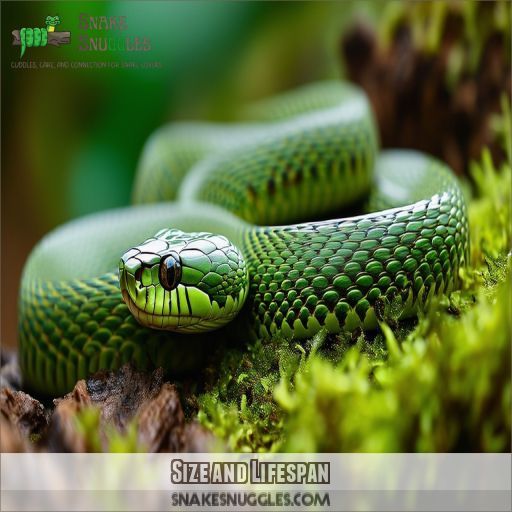This site is supported by our readers. We may earn a commission, at no cost to you, if you purchase through links.

Explore the challenges of caring for these specialized creatures and understand their conservation needs.
Whether you’re a reptile enthusiast or simply curious about unusual animals, this article will provide you with essential facts about the elephant trunk snake’s habitat, diet, and role in aquatic ecosystems.
Table Of Contents
- Key Takeaways
- Appearance and Behavior
- Size and Lifespan
- Housing Requirements
- Care Tips
- Reproduction and Conservation
- Frequently Asked Questions (FAQs)
- Are elephant trunk snakes poisonous?
- Can elephant trunk snakes be out of water?
- Why is it called an elephant trunk snake?
- How big are elephant trunk snakes?
- Are elephant trunk snakes venomous?
- How do they hunt in murky water?
- Can elephant trunk snakes be handled safely?
- Whats the origin of their unusual name?
- Do they have any natural predators?
- Conclusion
Key Takeaways
- These slithery swimmers are the ultimate masters of disguise, with baggy skin that’s not just a fashion statement – it’s their secret weapon for snagging prey!
- Talk about a power couple – female elephant trunk snakes can grow up to a whopping 8 feet long, while their male counterparts top out at a more modest 5 feet. Size matters in the snake world!
- These night owls are the ultimate couch potatoes of the reptile world, spending their evenings lounging in murky waters waiting for the perfect moment to strike. Who said being lazy couldn’t be productive?
- Keeping one of these unique reptiles as a pet isn’t for the faint of heart – they’re the divas of the snake world, requiring a spacious aquarium, live prey, and a "look but don’t touch" policy. High maintenance doesn’t even begin to cover it!
Appearance and Behavior
You’ll notice the elephant trunk snake’s distinctive tan coloration with a lighter yellow underside, complemented by its muscular build and short tail. As nocturnal ambush hunters, these unique aquatic reptiles spend their nights stealthily waiting to catch unsuspecting prey in their watery habitats.
Tan Hue With Light Yellow Ventral
You’ll find the elephant trunk snake‘s appearance quite striking. Its tan hue blends seamlessly with its aquatic environment, while the light yellow ventral adds a subtle contrast.
Don’t be fooled by its baggy wrinkles; this loose skin is a clever adaptation for hunting.
These nocturnal ambush predators thrive in salty habitats, using their unique coloration to catch unsuspecting prey in the murky waters they call home.
Muscular Build, Short Tail
You’ll notice the elephant trunk snake‘s muscular build and short tail right away. This unique reptile, also known as Acrochordus javanicus or Javan file snake, boasts a robust body covered in loose, wrinkly skin.
Its powerful muscles and compact form are perfectly adapted for ambush hunting in aquatic environments.
The snake’s short tail and wrinkled appearance give it an unmistakable look among its aquatic cousins.
Nocturnal, Ambush Hunters
You’ll find these snakes are true night owls, thriving in brackish blackwater with dense vegetation. Their hunting strategy is as unique as their appearance:
- They fold their loose skin around prey, using sharp scales to grip
- Their attack response is lightning-fast, leaving little chance for escape
- They’re masters of patience, waiting motionless for the perfect moment to strike
In captivity, a 150-gallon aquarium mimics their natural habitat, but habitat loss threatens wild populations. Captive breeding remains challenging, making conservation efforts essential.
Size and Lifespan
You’ll find significant size differences between male and female elephant trunk snakes, with males reaching up to 5 feet and females growing to an impressive 8 feet in length. These unique reptiles have a relatively short lifespan, typically living around 4 years in the wild and up to 5 years in captivity.
Males: Up to 5 Ft
You’ll find that male elephant trunk snakes are the smaller of the sexes, reaching up to 5 ft in length. This sex dimorphism plays a key role in their feeding habits and captive breeding efforts. Let’s break down some key facts:
| Characteristic | Male Elephant Trunk Snake |
|---|---|
| Max Length | Up to 5 ft |
| Water Temp | 84-86°F |
| Basking Temp | 88-90°F |
Conservation measures are important due to habitat loss threatening these unique creatures.
Females: Up to 8 Ft
You’ll be amazed to learn that female elephant trunk snakes can grow up to a whopping 8 feet in length! This striking sexual dimorphism showcases the incredible adaptations of these nocturnal hunters. Their larger size plays a vital role in their reproductive strategies:
- Females carry 6 to 17 developing eggs internally
- Offspring are born live, ready to tackle their aquatic world
- Larger mothers can potentially produce more offspring, boosting conservation efforts
Average Lifespan: 4 Years in the Wild, 5 Years in Captivity
While female elephant trunk snakes can grow up to 8 feet, their average lifespan is surprisingly short. You’ll find these unique reptiles living just 4 years in the wild and 5 years in captivity.
Stress management and health challenges play a significant role in their longevity. Conservation efforts and habitat protection are critical to supporting these fascinating creatures’ well-being.
With proper care, you might extend their captive lifespan through careful attention to their needs.
Housing Requirements
To house an elephant trunk snake, you’ll need a spacious aquarium with ample hiding spots, foliage, and a sandy substrate. For adult snakes, a 150-gallon tank is recommended, while juveniles can be kept in 15-30-gallon enclosures, with water temperature maintained between 84-86°F.
Aquarium With Hiding Spots, Foliage, and Sandy Substrate
To create a suitable aquatic habitat for your elephant trunk snake, you’ll need an aquarium that mimics its natural environment.
Provide plenty of hiding spots to accommodate its nocturnal behavior and ambush hunting style.
Include dense foliage and a sandy substrate to support its unique loose skin and trunk-like appearance.
This setup will help your snake feel secure and thrive in captive care.
Proper Tank Size and Water Temperature
For your elephant trunk snake, you’ll need a 150-gallon aquarium for adults, while juveniles can thrive in 15-30-gallon tanks.
Maintain water temperature between 84-86°F to mimic their natural habitat. Guarantee proper tank filtration and water circulation to keep conditions stable.
Use a low-level UV lamp for lighting, and create a cozy environment with appropriate substrate and tank decor for this unique aquatic reptile.
Care Tips
To care for an elephant trunk snake, you’ll need to minimize stress by avoiding handling and providing a calm environment. You should feed them live fish and amphibians, and watch for signs of white spot fungus, a common health issue in captive specimens.
Avoid Handling and Sources of Stress
When housing elephant trunk snakes, it’s essential to minimize handling and reduce stress. These shy creatures are prone to stress, which can lead to health issues like white spot fungus.
Observe their behavior from a distance and avoid unnecessary interaction. Only experienced snake keepers should handle them when absolutely necessary.
Create a calm environment by limiting noise, movement, and light exposure to promote their well-being in captivity.
Feed Live Fish and Amphibians
To keep your elephant trunk snake healthy, you’ll need to feed it live prey. These ambush hunters thrive on a diet of fish and amphibians. Here’s what you should know:
- Offer wild-caught feeder fish for wholesome nutrition
- Introduce live prey to mimic natural hunting techniques
- Vary the diet to prevent dietary restrictions
- Feed in a blackwater environment to reduce stress
- Be patient, as captive breeding challenges make wild-caught snakes common
Common Health Issue: White Spot Fungus
You’ll need to be vigilant for white spot fungus, a common health issue in elephant trunk snakes. Look out for little white spots on their skin, which often arise from poor water conditions.
If your snake lacks an appetite, act fast. Perform a partial water change and clean out the canister filter.
Fungal prevention involves maintaining ideal environmental factors, providing immune support, and reducing stress.
Reproduction and Conservation
Elephant trunk snakes are ovoviviparous, meaning females retain eggs internally until they hatch, giving birth to live young after a 5-6 month gestation period. While captive breeding remains challenging, these unique reptiles face population declines in the wild due to habitat loss, making conservation efforts essential for their long-term survival.
Ovoviviparous Reproduction
You’ll find the elephant trunk snake’s reproductive strategy fascinating. These primitive aquatic snakes are ovoviviparous, meaning embryos develop inside eggs within the mother’s body. Unlike viviparity, the young hatch from these eggs just before birth. This evolutionary adaptation provides greater reproductive efficiency and parental investment.
Incubation lasts half a year, with females giving birth to 6-17 live young. The newborns’ loose, baggy skin develops as they mature.
Challenges in Captive Breeding
You’ll find captive breeding of elephant trunk snakes incredibly challenging. Environmental mimicry and hormonal triggers are essential yet difficult to replicate. Genetic diversity is limited, and stress factors abound in captivity.
These nocturnal carnivores are reluctant to eat around humans, making nutrition tricky. Pathogen control is essential, as they’re prone to infections.
While available in specialty reptile stores, they’re difficult to care for, requiring expertise in aquatic habitats and their unique needs to breathe air.
Population Decline Due to Habitat Loss
While captive breeding remains a challenge, the elephant trunk snake faces an even greater threat in the wild. Habitat loss, combined with hunting pressure, is causing their population to decline.
Climate change and habitat fragmentation are altering the brackish waters they call home, reducing prey availability.
Conservation efforts are imperative to protect these unique reptiles, their tannin-rich habitats, and their basking spots from further destruction.
Frequently Asked Questions (FAQs)
Are elephant trunk snakes poisonous?
With over 3,500 known snake species, you might be surprised to learn elephant trunk snakes aren’t poisonous. They’re non-venomous aquatic predators that use their unique body shape and sharp scales to catch prey, rather than relying on venom for hunting.
Can elephant trunk snakes be out of water?
You can’t keep these aquatic creatures out of water for long. They’re not built to support their weight on land. While they might briefly emerge, they’re most comfortable and healthy when fully submerged in their watery habitat.
Why is it called an elephant trunk snake?
You’ll find the name quite fitting when you see this snake’s unique appearance. Its loose, baggy skin and broad snout resemble an elephant’s trunk. This distinctive feature helps it catch prey and navigate through water.
How big are elephant trunk snakes?
You’ll find these snakes measuring up to 8 feet for females and 5 feet for males. They’re sexually dimorphic, with females growing larger. In captivity, they’re typically smaller, averaging 6-22 pounds in weight.
Are elephant trunk snakes venomous?
You’ll be relieved to know they’re not venomous. These snakes rely on their unique body shape and hunting technique to catch prey. Their teeth, while sharp, aren’t connected to venom glands. They’re harmless to humans unless provoked.
How do they hunt in murky water?
Did you know these snakes can stay underwater for up to 40 minutes? You’ll find them using their keen senses in murky waters. They’re patient ambush predators, relying on vibrations and scent to locate prey before striking.
Can elephant trunk snakes be handled safely?
You shouldn’t handle these snakes safely. They’re shy, easily stressed, and can inflict serious injuries when provoked. Their teeth often remain stuck in flesh. It’s best to observe them from a distance in their aquatic habitat.
Whats the origin of their unusual name?
You’d be surprised to learn the name’s origin! It’s not about elephants at all. The snake’s baggy, wrinkled skin resembles an elephant’s trunk. This unique feature inspired its unusual moniker, perfectly capturing its distinctive appearance.
Do they have any natural predators?
You might wonder about natural predators for these unique creatures. While they’re skilled ambush hunters, they’re not invincible. Large fish, crocodiles, and even birds of prey can pose a threat to their survival in the wild.
Conclusion
Like a living puzzle piece in aquatic ecosystems, the elephant trunk snake captivates with its unique adaptations. You’ve discovered its distinctive appearance, nocturnal habits, and specialized care needs.
As you reflect on this remarkable reptile, remember the challenges it faces in the wild. By understanding and appreciating the elephant trunk snake’s role in nature, you’re contributing to its conservation.
Whether you’re a seasoned herpetologist or a curious nature lover, this species serves as a reminder of the incredible diversity thriving beneath the water’s surface.











